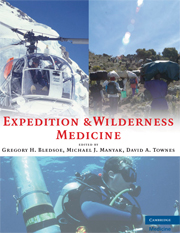Book contents
- Frontmatter
- Contents
- Contributors
- Foreword
- Preface
- Acknowledgments
- PART I EXPEDITION PLANNING
- PART II EXPEDITIONS IN UNIQUE ENVIRONMENTS
- PART III ILLNESS AND INJURIES ON EXPEDITIONS
- 24 General Medical
- 25 The Diarrhea of Travelers
- 26 Malaria: Diagnosis, Prevention, and Treatment for the Traveler
- 27 Wild Animal Attacks and Injuries
- 28 Snake and Arthropod Envenoming
- 29 Hazardous Marine Life
- 30 Expedition Toxicology
- 31 Environmental Injuries
- 32 Penetrating and Explosive Wounds
- 33 Drowning and Submersion Injury
- 34 Evaluation and Acute Resuscitation of the Trauma Patient
- 35 Principles and Practice of Expedition Wound Management
- 36 Expedition Eye Injuries and Disorders
- 37 Dental Medicine on Expedition
- 38 Foot Injuries
- 39 Expedition Orthopedics
- 40 Expedition Self-Rescue and Evacuation
- 41 Aeromedical Evacuations
- APPENDIX The Expedition Medical Kit
- Index
25 - The Diarrhea of Travelers
from PART III - ILLNESS AND INJURIES ON EXPEDITIONS
Published online by Cambridge University Press: 05 March 2013
- Frontmatter
- Contents
- Contributors
- Foreword
- Preface
- Acknowledgments
- PART I EXPEDITION PLANNING
- PART II EXPEDITIONS IN UNIQUE ENVIRONMENTS
- PART III ILLNESS AND INJURIES ON EXPEDITIONS
- 24 General Medical
- 25 The Diarrhea of Travelers
- 26 Malaria: Diagnosis, Prevention, and Treatment for the Traveler
- 27 Wild Animal Attacks and Injuries
- 28 Snake and Arthropod Envenoming
- 29 Hazardous Marine Life
- 30 Expedition Toxicology
- 31 Environmental Injuries
- 32 Penetrating and Explosive Wounds
- 33 Drowning and Submersion Injury
- 34 Evaluation and Acute Resuscitation of the Trauma Patient
- 35 Principles and Practice of Expedition Wound Management
- 36 Expedition Eye Injuries and Disorders
- 37 Dental Medicine on Expedition
- 38 Foot Injuries
- 39 Expedition Orthopedics
- 40 Expedition Self-Rescue and Evacuation
- 41 Aeromedical Evacuations
- APPENDIX The Expedition Medical Kit
- Index
Summary
INTRODUCTION
International travel, which is increasing at a rapid rate, is a most rewarding way to experience different cultures, wonders of nature and the beauties of human inventiveness, and, of course, the culinary arts. Traveling to the developing world, however, where water and sanitation are less than adequate, becomes a significant obstacle when ingesting the wonderful cuisine of those countries. The traveler then often faces the challenge of dealing with the most common of travelers' diseases, acute diarrhea, or as it is usually referred to, travelers' diarrhea. Over the years, this illness has been given colorful names to describe its symptomatology, based on its location: Montezuma's Revenge, Delhi Belly, and Aztec two-step, to name a few. All of these very appropriate names refer to the same illness: travelers' diarrhea. This illness was first officially recognized and named in the 1950s by Kean (Kean, Waters, 1958) when it commonly occurred among students and vacationers traveling to Mexico and other developing countries. Initial studies for etiologic agents were all negative (using the available techniques at the time), and it was thought perhaps to be due to changes in the mineral concentrations of the drinking water, changes in gut flora, or even jet lag.
Our understanding of the disease changed remarkably in the mid-1970s, when it became clear that most cases of travelers' diarrhea were, indeed, due to infectious agents, the most common being enterotoxigenic E. coli (ETEC).
- Type
- Chapter
- Information
- Expedition and Wilderness Medicine , pp. 352 - 360Publisher: Cambridge University PressPrint publication year: 2008

